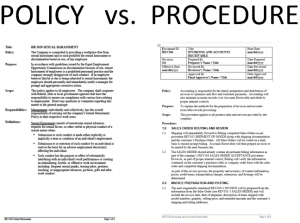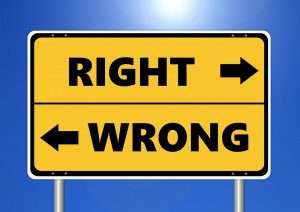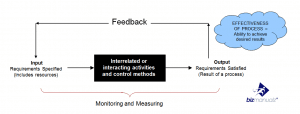Can You Have a Procedure Without a Policy?

Do policies and procedures go together in any organization or institution? Yes, they do! Policies provide a framework for decision-making and guide individuals on how to handle various situations. But can you have a procedure without a policy? Not as straightforward as it seems.
Understanding Procedures and Policies
Policies refer to a set of guidelines or rules that control individual behavior or actions. These help ensure consistency, fairness, and compliance with legal needs. On the other hand, procedures are step-by-step instructions to carry out a task or activity. Policies provide the basic principles. Procedures focus on details of implementation.
Not all organizations stick to this strict distinction between policies and procedures. Sometimes, procedures are developed first based on industry best practices or operational needs. Then policies are created to cover these procedures. Policies are used to formalize existing practices, not dictate them from the start.
Sometimes, procedures exist without formal policies. This works for a while, but can lead to inconsistency and confusion in the long run. So, having documented policies is highly recommended for every organization.
The connection between policies and procedures is key for good management. Procedures set out step-by-step instructions to carry out tasks and processes, while policies provide rules and guidelines for decisions and behavior.
Without policies, procedures lack clarity and consistency, causing confusion and inefficiency. And without procedures, policies become just words without any practical use. The two go hand in hand for smooth running of an organization and reaching goals.
To show the difference, here’s a table:
| Procedures | Policies | |
|---|---|---|
| Focus | Action-oriented | Decision-oriented |
| Scope | Specific to tasks or processes | Broadly applicable |
| Detail | Step-by-step instructions | Rules, guidelines, principles |
| Change | Frequently updated based on operational needs | Relatively stable over time |
| Examples | Document review process | Code of conduct |
Plus, procedures are about “how” while policies are about “what” and “why“. Both are essential for organization regulation.
For a successful connection between policies and procedures:
- Communicate clearly: Create a plan to inform employees about procedure execution and policy expectations.
- Involve stakeholders: Ask relevant people to develop and review procedures and policies to get their input and make sure they are relevant.
- Regularly review/update: Check how effective procedures are and review policies to keep up with industry standards or organizational changes.
These points help form a system that allows efficient operations while following rules and guidelines, leading to better performance, accountability and success.
The Relationship between Procedures and Policies

employment policies
Policies and procedures are closely connected. Procedures are sets of step-by-step instructions for using policies correctly. Policies provide guidelines and objectives, while procedures show what actions are needed to reach the goals.
The table below illustrates this relationship:
| Policies | Procedures |
|---|---|
| Set of rules | Step-by-step guide |
| Guidelines | Implementation plan |
| Objectives | Actions required |
Policies create a framework for decisions. They state what is expected of people and departments to follow regulations. On the other hand, procedures explain how tasks should be done to stick to the policies.
By making procedures that follow policies, organizations make sure their operations are consistent, effective, and clear. Procedures protect against risks of non-compliance by giving a structured way to use policies.
Pro Tip: Review and update procedures to reflect any policy changes or best practices. This allows the organization to stay relevant and effective.
Can a procedure exist without a policy? Only if you want to do operation blindfolded with a chainsaw.
Can a Procedure Exist Without a Policy?
Can a procedure exist without a policy? The answer is complex. Business policies set the guidelines and limits for an organization or system. They decide objectives, expectations, and limitations. On the other hand, procedures are instructions on how to do something.
Can a procedure thrive without a policy? It depends on understanding the relationship between them. Policies provide a strong base for procedures. Policies make sure everything is consistent and fair. Without policies, procedures may be missing legitimacy or vary from one person to another.
Let’s look at a real-life example. In a healthcare facility, there was no policy for emergencies. Each team had their own way of dealing with patients in critical condition. This caused inconsistencies and wasted resources.
Management created a policy for emergency response protocols. This made it easier to develop procedures on how to treat patients based on severity of condition.
The Role of Policies in Shaping Procedures
Policies are vital for forming procedures. They supply directions and principles that help organizations form productive practices. Without policies, procedures may lack organization, consistency, and adhering to laws. Let’s examine the effects of how policies affect procedures.
To illustrate the importance of policies in creating procedures, let us look at this table:
| Policy | Procedure |
|---|---|
| Security | Access control measures |
| Quality Assurance | Testing protocols |
| Workforce | Recruitment guidelines |
As seen in the table, policies directly influence the related procedure. For instance, security policies determine access control measures to secure sensitive data. Similarly, quality assurance policies create testing protocols to guarantee product quality. Workforce policies describe recruitment guidelines to recruit qualified candidates.
Going further and examining special aspects, we detect more subtle details. Policies not only create a structure for procedures but also foster openness in an organization. By setting definite expectations and describing acceptable behavior, policies add to a beneficial work culture.
In fact, the concept of policies impacting procedures goes back centuries. In ancient civilizations, codes of conduct were constructed to govern different parts of social life. These early forms of policies prepared the way for structured procedures that allowed societies to work together peacefully.
Having both procedures and policies is like having a back-up plan for your back-up plan – it’s the safety net that ensures chaos is a very unlikely, but amusing, prospect.
Benefits of Having Both Procedures and Policies
Having policies and procedures can bring many advantages to an organization. They offer structure, clarity, and uniformity in how tasks are done, ensuring smooth operations and reducing risks. Proper rules and regulations can make businesses more productive, efficient, and successful.
- Clear Guidelines: Policies and procedures give employees precise instructions on how to complete their tasks. This understanding raises productivity, lessens mistakes, and ensures consistent quality of work.
- Risk Mitigation: Policies and procedures help identify any potential risks within an organization’s operations. By outlining steps to reduce these risks, businesses can avoid incidents that could damage their reputation or financial stability.
- Compliance Adherence: Companies often have to meet particular legal or regulatory requirements. Having the correct policies and procedures means employees follow these rules consistently. This keeps organizations away from penalties or legal issues while staying ethical.
- Conflict Resolution: Procedures and policies provide a structured approach to resolving conflicts or addressing issues within the organization. Employees can refer to these rules when facing disagreements or challenges, encouraging fair resolutions that are in line with company values.
Also, having policies and procedures can boost employee morale by making them feel secure knowing what is expected of them. It also promotes transparency as everyone knows the set rules and processes.
To make the most of policies and procedures:
- Regular Review: Ensure that policies and procedures are examined and updated regularly. This keeps them relevant in a changing business climate where practices can change.
- Training & Communication: Train employees properly on the policies and procedures so they completely understand their role in following them. Regular communication about any updates or changes is also important to keep everyone informed and united.
- Flexibility: While policies and procedures offer structure, it is essential to let room for adaptability and flexibility. Encourage employees to suggest improvements or identify areas where the rules may not be effective, creating a culture of continuous improvement.
By actively following these tips, organizations can make the most of having both policies and procedures in place. This leads to enhanced productivity, risk management, compliance adherence, conflict resolution, employee morale, and organizational success – all of which are essential for success! Not having policies is like playing operation without a doctor – a risk-filled game of chance with no safety net for the patient.
Procedure without a Policy
Can a procedure exist without a policy? After close examination, the answer is no. Policies are the law of the land, providing the framework for successful organizations. Procedures are the practical steps for following the policies and ensuring uniformity in decision-making.
The healthcare sector is a great example of this relationship between policies and procedures. Healthcare organizations have strict policies about medication administration, which are then implemented via detailed procedures. These procedures are like a roadmap, guiding healthcare staff to complete complex tasks properly and reduce errors.
To sum up, policies and procedures are essential partners in organizational management. Policies establish the rules and expectations, while procedures show how to reach the objectives. Together, they create a system where everyone works together towards the same goal.
Frequently Asked Questions
1. Can a procedure be conducted without a policy in place?
While it is possible to conduct a procedure without a policy, it is not recommended. Policies provide guidelines and expectations for the procedure and ensure that it is carried out consistently and safely.
2. What is the importance of having a policy for a procedure?
Policies provide clear guidelines and expectations for the procedure, ensure that it is carried out consistently, and minimize the risk of errors, accidents, or oversights.
3. What are the consequences of conducting a procedure without a policy?
Conducting a procedure without a policy may lead to inconsistent and unsafe practices, which can result in errors, accidents, injuries, or legal liabilities.
4. Can a company be held liable if a procedure is conducted without a policy?
Yes, a company can be held liable if a procedure is conducted without a policy and the consequences of the procedure result in harm or damages to individuals, property, or reputation.
5. Who is responsible for creating policies for procedures?
The responsibility for creating policies for procedures typically falls on the management team or the relevant department in charge of the procedure.
6. How often should policies for procedures be reviewed and updated?
Policies for procedures should be reviewed periodically, particularly when there are changes in regulations, technologies, or best practices. Some organizations review their policies annually, while others conduct reviews quarterly or biannually.















Leave a Reply